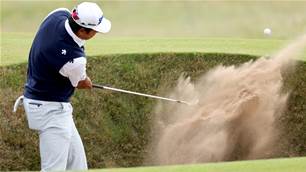The 156 players that took to the Royal Troon course for the first round played the brutal 11th – The Railway Hole – in a combined total of 108 over par, writes Brendan James
BY BRENDAN JAMES at ROYAL TROON
ON his way to winning the 1962 Open Championship at Royal Troon, Arnold Palmer described the course’s notorious 11th as “the most dangerous hole I have ever seen.”
A few days later, Jack Nicklaus, on his Open debut, ran up a quintuple bogey 10 after driving into the gorse, having an air swing and then hitting his ball onto the adjoining railway line.
Known as the ‘Railway’ hole, it is 482 yards (440 metres) of nail-biting terror, especially in the wind. A four-foot high stone wall separates the hole from the railway, which is obviously out-of-bounds, while any drive left or slightly right of the fairway is dead in the gorse.
 The Railway hole is 490 yards between gorse and the railway tracks.
The Railway hole is 490 yards between gorse and the railway tracks.PHOTO: David Cannon/Getty Images.
When Nicklaus made his 10 it was a par-5. It was changed to a par-4 for the first time at the 1997 Open, making it Royal Troon’s most difficult hole … by a long way. In 2004, it averaged 4.41 over the four rounds of the championship. The scoring average there was even higher during the opening round of this 145th Open.
The 156 players that took to the course for the first round played the treacherous 11th in a combined total of 108 over par at an average of 5.78. Only six players managed to birdie ‘Railway’ including two former Troon Open Champions – Mark Calcavecchia and Justin Leonard.
“It’s playing a lot easier this afternoon,” said Leonard, the 1997 champion, who carded an opening round of 70.
“I hit driver up there and a five iron into about 12 feet or so and made the putt. It’s a much easier hole. I watched a bit of TV coverage this morning, about 10 minutes or so, and saw where the guys were driving it too on 4 and 6 and we weren’t able to get there, so I’m sure it was playing differently this morning.”
Indeed it was.
American Billy Horschel, who is tied fourth after his opening round 67, parred ‘Railway’ but called it one of the “toughest holes I have ever played.”
“It's just a scary tee shot. You just can't see where you're going,” Horschel said.
“The way the fairway angles and the way the wind comes in and off the left it's just a tough tee shot, especially for a right-handed golfer. If it's not blowing too hard into you, you can carry. Obviously there's gorse about 250 (yards) and there is this mound with a lot of nasty stuff behind it that's about 285. If it's not blowing into me I can carry that so my right line can be a little further right, but if it's into me I can't do that, the longer guys can. It's just a scary tee shot.
 Matt Jones had a costly double bogey on th 11th in his opening round.
Matt Jones had a costly double bogey on th 11th in his opening round.PHOTO: Mike Ehrmann/Getty Images.
“I remember I heard my caddie tell me Jack Nicklaus when he played it, he just hit 2-iron, 2-iron and played it as a four and a half, and tried to play at two-over par for the weekend. I think that maybe was when the hole was a little shorter. But it's a tough tee shot. Just the hole, you've got to sack up and hit a couple good shots. At worst, walk off with no worse than a bogey.”
There were plenty of players who wished they had walked off the 11th green with a bogey, instead of trudging to the 12th tee feeling like that had been hit by the regularly passing Ayr to Glasgow Express.
David Duval, who lifted the Claret Jug in 2001, racked up a quintuple bogey nine there when the wind was at its strongest in the morning. Playing partners Sandy Lyle, the 1985 Open Champion, and British Amateur Champion Scott Gregory were narrowly better with triple-bogey sevens. The trio, having played a combined 23 shots on the hole, was put on the clock by officials for slow play, which might have a bit harsh.
 David Duval finished with a 9 on the 11th. PHOTO: Andy Buchanan/AFP/Getty Images.
David Duval finished with a 9 on the 11th. PHOTO: Andy Buchanan/AFP/Getty Images.Queensland Steven Bowditch and reigning Australian Open Champion Matt Jones were also among the high-scoring scalps claimed by the Railway hole.
Bowditch was only one over when he reached the 11th tee, but 15 minutes later he was six over and had all but played his way out of the tournament. He finished with an eight over 79 and left the course in a hurry after submitting his card.
Luckily the Ayr to Glasgow Express wasn’t speeding by when Jones was on the tee. He launched his drive well right onto the train line, and admitted later he didn’t see exactly where it finished because he looked away in disgust, knowing he had blown the good work of getting to five under through 10 holes.
“It’s a very tough tee shot because you see nothing but trouble,” he said.
“You see the gorse left, which is re-tee anyway, and you see trouble right with the train track. The wind’s off the left, so you have to hit driver and I just got underneath it and hit it right, then I made a great double bogey actually.”
Jones did, however, recover some lost ground with a birdie at the 17th to finish at two under is tied for 22nd heading into the second round.
With some heavy rain and high winds expected over the next two days at least, the beast that is the Railway Hole will devour a few more players before this Open is done.
Related Articles

The Aussies at The Open

Column: Rory will grab the headlines but Portrush will steal the show













